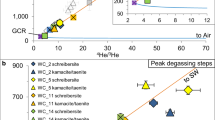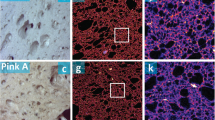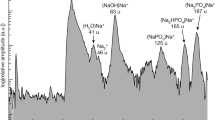Abstract
Iron cosmic spheres, composed of iron oxides surrounding a FeNi metal core, were discovered more than a century ago during the voyage of the HMS Challenger1. That tbe spheres originated by atmospheric melting of meteoritic metal is supported by a variety of evidence, including elemental composition2, the presence of the metastable oxide wustite3, similarity to analogues produced in the laboratory4 and content of 53Mn produced by exposure to cosmic rays5. We report here a previously unrecognized property of the spheres. The most common spheres larger than 300 µm do not, in fact, contain FeNi metal cores, but instead contain a micrometre-sized nugget composed almost entirely of platinum group elements. These elements appear to have been concentrated by the oxidation of molten meteoritic metal during atmospheric entry. This process is critically dependent on the relative abundance of oxygen in the atmosphere, and the first appearance of the nuggets in the geological record may provide a marker indicating when the oxygen abundance attained half of its present level.
This is a preview of subscription content, access via your institution
Access options
Subscribe to this journal
Receive 51 print issues and online access
$199.00 per year
only $3.90 per issue
Buy this article
- Purchase on Springer Link
- Instant access to full article PDF
Prices may be subject to local taxes which are calculated during checkout
Similar content being viewed by others
References
Murray, S. & Renard, A. F. Rep. Scientific Results Voyage HMS Challenger Vol. 3 (Neill, Edinburgh, 1891).
Castaing, R. & Fredricksson, K. Geochim. cosmochim. Acta 14, 114–117 (1958).
Marvin, V. B. & Einaudi, M. T. Geochim. cosmochim. Acta 31, 1871–1884 (1967).
Blanchard, M. B. & Davis, A. J. geophys. Res. 83, 1793–1808 (1978).
Nishiizumi, K. Earth planet. Sci. Lett. 63, 223–228 (1983).
Brownlee, D. E., Pilachowski, L. B. & Hodge, P. W. Lunar planet. Sci. 10, 157–158 (1979).
Schamber, F. in X-Ray Fluorescence Analyses of Environmental Samples (ed. Dzubay, T. G.) 241–257 (Ann Arbor Science, 1975).
Wark, D. A. Astrophys. Space Sci. 65, 275–295 (1979).
Palme, H. & Wlotzka, F. Earth planet. Sci. Lett. 33, 45–60 (1976).
Fechtig, H. & Uteck, K. Ann N.Y. Acad. Sci. 119, 243–249 (1964).
Gibbons, R. V., Horz, F., Thompson, T. D. & Brownlee, D. E. Proc. 7th Lunar Sci Conf. 863–880 (1976).
Brett, R. Am. Miner. 52, 721–733 (1967).
Brownlee, D. E. in The Sea Vol. 7 (ed. Emiliani, C.) 733–762 (Wiley Interscience, New York, 1981).
Reed, T. B. Free Energy of Formation—An Atlas of Charts for High Temperature Chemical Calculations (MIT Press, Cambridge, 1971).
St. Clair, H. W. in Vacuum Metallurgy (ed. Bunshah, R. F.) 295–305 (Reinhold, New York 1958).
Honig, R. E. in Characterization of High Temperature Vapors (ed. Margrave, J. L.) 475–494 (Wiley, New York, 1967).
Crockett, J. H. Geochim. cosmochim. Acta 36, 517–535 (1972).
Brownlee, D. E., Bates, B. & Beauchamp, R. H. in Chondrules and their Origins (ed. King, E.) 10–25 (Lunar Planetary Institute, Houston, 1983).
Alvarez, L. W., Alvarez, W., Asaro, F. & Michel, H. V. Science 208, 1095–1108 (1980).
Anders, E. & Ebihara, M. Geochim. cosmochim. Acta 46, 2363–2380 (1982).
Author information
Authors and Affiliations
Rights and permissions
About this article
Cite this article
Brownlee, D., Bates, B. & Wheelock, M. Extraterrestrial platinum group nuggets in deep-sea sediments. Nature 309, 693–695 (1984). https://doi.org/10.1038/309693a0
Received:
Accepted:
Issue Date:
DOI: https://doi.org/10.1038/309693a0
This article is cited by
-
Recovery of hydrothermal wustite-magnetite spherules from the Central Indian Ridge, Indian Ocean
Scientific Reports (2022)
-
A Tunguska sized airburst destroyed Tall el-Hammam a Middle Bronze Age city in the Jordan Valley near the Dead Sea
Scientific Reports (2021)
-
Geochemical characteristics of platinum-group elements in polymetallic nodules from the Northwest Pacific Ocean
Acta Oceanologica Sinica (2020)
-
RETRACTED ARTICLE: Unaltered cosmic spherules in a 1.4-Gyr-old sandstone from Finland
Nature (1998)
-
The coupled Re-Os and Pt-Os systematics: A theoretical consideration
Chinese Journal of Geochemistry (1995)
Comments
By submitting a comment you agree to abide by our Terms and Community Guidelines. If you find something abusive or that does not comply with our terms or guidelines please flag it as inappropriate.



